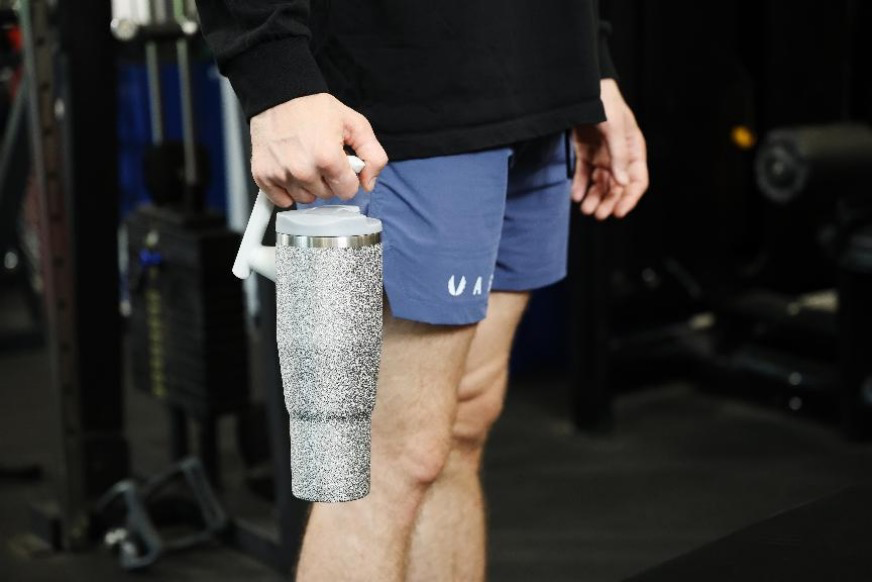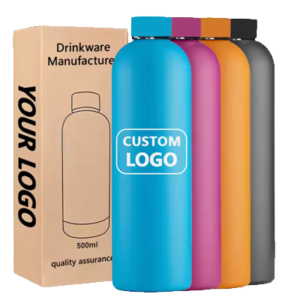Why Are Tumblers More Expensive Than Regular Vacuum Water Bottle?
In recent years, the vacuum water bottle market—especially in North America and Europe—has seen a surge in the popularity of tumblers. Whether it’s outdoor enthusiasts or urban professionals, it seems like everyone has a large-capacity tumbler. Major brands have even experienced instances where their tumblers sell out instantly upon release, making them highly sought-after. Tumblers have become more than just drinkware; they are now a symbol of lifestyle and fashion.
However, if you’ve paid attention to pricing, you may have noticed that tumblers are generally more expensive than traditional insulated flasks. This raises the question: Why do tumblers cost significantly more than regular vacuum water bottles? Is it purely due to market hype and fashion trends, or are there deeper reasons behind the higher price tag?
Table of Contents
ToggleWhat Makes Tumblers Different from Regular Vacuum Water Bottles?
Tumblers differ from traditional vacuum water bottles in several key aspects:
Larger Capacity – Tumblers typically come in larger sizes compared to regular vacuum water bottles. This makes them ideal for outdoor adventurers, long-distance drivers, or anyone who needs to stay hydrated for extended periods.
Premium Materials – While most regular vacuum water bottles use standard stainless steel, high-end tumblers often feature special coatings that provide enhanced scratch resistance and durability. These coatings also help prevent flavor retention and odors, ensuring a purer taste for different beverages.
Stylish Design – Traditional insulated flasks prioritize practicality, often featuring a simple, elongated cylindrical shape. Tumblers, on the other hand, have a wider mouth and a tapered base, offering a more ergonomic and visually appealing design. They also come in a variety of colors and finishes, making them more fashionable.
Enhanced Accessories – Unlike regular vacuum water bottles, which usually come with a simple screw-on lid, tumblers often include additional accessories such as straws and handles. These features improve usability, making it easier to drink with one hand—perfect for driving, exercising, or other on-the-go activities.
Versatile Usage Scenarios – Regular vacuum water bottles are commonly used for home or office settings, primarily for keeping drinks warm. Tumblers, with their stylish aesthetics and large capacity, are favored for outdoor activities like picnics, camping, and road trips. They have even become trendy lifestyle accessories, further contributing to their higher price.
In short, tumblers are not just about insulation; they combine functionality, style, and versatility, which justifies their premium pricing in the market.
Factors Influencing the Price of Tumblers
The high price of tumblers comes down to a combination of factors, from materials and craftsmanship to design details and brand value.
First, material costs play a fundamental role. Tumblers are often made from high-quality stainless steel or feature special coatings, which are inherently more expensive than the materials used in standard vacuum water bottles. This also brings production challenges, as maintaining insulation and durability while achieving a sleek design requires more advanced manufacturing techniques.
Design and development also contribute to the cost. Tumblers are not just about looks—they need to be ergonomically designed for a comfortable grip and seamless user experience. Additional features like built-in straws or handles further complicate the design and production process, adding to overall costs.
Finally, brand value and market demand significantly impact pricing. Many brands position tumblers as more than just drinkware; they market them as lifestyle accessories, adding perceived value that justifies a higher price.
In short, tumbler pricing isn’t driven by a single factor. It’s the result of a combination of material quality, production complexity, design innovation, branding, and consumer demand. But how exactly do these elements influence the final price?
How Manufacturing Affects Tumbler Pricing
1. Material Costs
Compared to regular insulated flasks, tumblers demand premium materials, especially for outdoor durability. Most high-end tumblers use 304 or 316 stainless steel, known for its superior corrosion resistance, high nickel and chromium content, and ability to prevent lingering odors. This naturally increases raw material costs.
Beyond stainless steel, many tumblers incorporate:
- Food-grade straws made from stainless steel, PP, or silicone, ensuring safety and durability.
- Scratch-resistant ceramic coatings inside to improve taste retention and prevent wear.
- Copper plating on the interior for enhanced insulation.
- Advanced CMF (Color, Material, Finish) techniques, adding premium aesthetics and durability.
- Larger tumblers also require more raw materials for both the inner and outer layers, further pushing up costs.
2. Advanced Manufacturing Techniques
Larger tumblers pose significant production challenges.
- Lightweight Materials – To keep them portable, manufacturers must balance durability with weight reduction.
- Enhanced Insulation – Maintaining temperature for larger liquid volumes requires innovative technology, such as:
- Thicker inner walls to minimize heat loss.
- Lead-free welding for superior heat retention.
- Advanced vacuum insulation, it uses a vacuum-sealed stainless steel layer to reduce heat transfer.
These proprietary techniques demand specialized equipment and meticulous quality control, naturally driving up costs.
3. Accessory & Feature Design
Tumblers are more than just vacuum water bottles—they serve as multi-purpose drinkware, sometimes even outdoor gear. Their added functionality requires careful accessory design:

- Straws – Must be food-safe, heat-resistant, and designed for optimal flow. The diameter, length, and bend angle are carefully tested for comfort and safety.
- Handles – More than just a loop, they are ergonomically designed for a comfortable, stable grip. Some are foldable for storage, while others feature anti-slip rubber coatings.
- Lids – A crucial component for insulation and leak prevention, requiring:
- Spill-resistant seals.
- Heat-resistant, easy-to-clean materials.
- Various drinking options (direct sip, straw-compatible, etc.).
Even seemingly minor accessories like straw brushes, coffee filters, or silicone sleeves require extensive design refinement, adding to production costs.
4. Aesthetic & Ergonomic Design
Tumblers are no longer just functional—they’ve become lifestyle accessories, especially in Western markets where they dominate social media trends. Their design and finish play a key role in pricing:

Premium Surface Treatments
Unlike standard vacuum water bottles with simple paint coatings, high-end tumblers feature:
- Matte, textured finishes for a sleek look and better grip.
- Electroplating, ice-pattern coatings, and nanotech finishes for durability.
- Unique CMF (Color, Material, Finish) processes that require precision equipment and multiple quality checks.
- Ergonomic Body Shape – Tumblers often feature a tapered waist for better grip, optimized for single-handed use and car cup holder compatibility. These refinements require extensive 3D modeling and real-world testing to perfect.
Functional Design Meets Aesthetics
Elements like embossed surfaces improve grip while enhancing style. For instance, a brand’s signature hammered finish was originally designed to hide scratches but has since become an iconic design feature.
The higher price of tumblers is not just about branding or market hype. Every detail—from premium materials and insulation technology to ergonomic design and high-end aesthetics—contributes to their value. While they may cost more than regular vacuum water bottles, they offer superior durability, performance, and a refined user experience, making them a worthwhile investment.
How Brand Premiums Influence Tumbler Pricing
Leading tumbler brands have built strong brand loyalty through years of market presence and word-of-mouth marketing. However, brand premiums go far beyond just a logo. From collaborations and marketing strategies to event sponsorships and lifestyle branding, premium tumbler brands create a compelling image that encourages consumers to willingly pay a higher price. Buying a high-end tumbler isn’t just about purchasing a product—it’s about embracing a lifestyle and identity.
1. Branding Strategy:Limited Editions & Collaborations
Brand collaborations have become a powerful tool for increasing perceived value. By partnering with renowned artists, fashion labels, and pop culture icons, tumblers evolve from functional drinkware into collectible items.
Collaborative Editions & Premium Pricing
Tumblers often collaborate with well-known IPs, these partnerships elevate the artistic and cultural appeal of the product, turning tumblers into symbols of style and individuality. Additionally, they attract new consumer groups—especially younger audiences—who might not have otherwise considered buying a tumbler.
Seasonal Colors & Limited Releases
Brands also leverage seasonal exclusives to drive demand. For instance, Japan-exclusive cherry blossom tumblers feature embossed floral designs and thermochromic coatings that change color in sunlight. Despite being priced significantly higher than standard models, these limited editions often sell out instantly, with fans even lining up overnight to purchase them. This showcases how brands use scarcity and emotional appeal to fuel consumer desire.
Cultural Symbolism in Design
Many tumblers integrate regional and cultural elements into their designs, such as Haers’ collaboration with the Forbidden City, Japanese Ukiyo-e prints, or Western street art. These cultural crossovers transform tumblers into artistic and collectible items, appealing to consumers who seek uniqueness, exclusivity, and sentimental value.
2. Emotional Marketing & Lifestyle Positioning
Premium tumbler brands excel at creating emotional connections with their customers.
A big brand invests heavily in documentary-style videos, featuring athletes, hunters, and outdoor enthusiasts using their products in real-world conditions. By associating its brand with rugged outdoor lifestyles, it builds a strong emotional connection with its core audience. These campaigns don’t just showcase product durability (shockproof, pressure-resistant, and freeze-proof features)—they reinforce the brands’ alignment with consumer values, making the brand feel like an essential part of their lifestyle.
Some brands, on the other hand, focus on eco-conscious branding, promoting the use of recyclable materials and carbon footprint reduction. With its stylish designs and sustainability message, the brand has become a staple in offices, gyms, and social media feeds, appealing to younger, environmentally aware consumers.

3. How Branding Shapes Consumer Perception
A well-crafted brand identity elevates a tumbler from a simple drinking vessel to a lifestyle accessory. Through targeted marketing and emotional storytelling, premium brands make consumers feel like the product was designed specifically for them.
On the other hand, standard insulated flasks mainly serve practical purposes, with simple designs and fewer unique features. In this segment, brand loyalty is lower, and consumers tend to prioritize cost-effectiveness over branding. This results in a highly competitive market where price wars are common.
By contrast, premium brands differentiate themselves through storytelling, emotional engagement, and exclusivity, attracting consumers who are willing to pay for perceived value rather than just functionality.
How Market Demand Shapes the Pricing Structure of Tumblers
The demand for tumblers has been steadily increasing in recent years, particularly in specialized segments such as straw tumblers, coffee tumblers, and fitness bottles. This diversification in consumer needs directly impacts tumbler pricing, reinforcing its dominant position in the high-end market.
1. Diversified Consumer Scenarios
With the global rise of coffee culture, demand for dedicated coffee tumblers has surged. For example:
- Office Use: Some tumblers feature a one-touch lid and leak-proof design, and have become a favorite among office workers, often selling out due to high demand.
- Fitness & Outdoor Activities: The growing emphasis on health and fitness has fueled interest in large-capacity, highly portable straw tumblers, which are particularly popular among athletes and gym-goers.
- Car Travel: Commuters and road-trippers favor spill-proof and long-lasting insulated car tumblers designed to fit into cup holders.
- Hygiene-Conscious Consumers: As health awareness increases, straw tumblers have gained popularity for their convenience and hygiene benefits, catering to those who prefer drinking without direct lip contact.

These trends highlight how evolving consumer habits and lifestyle needs drive innovation in tumbler design. The demand for more specialized, function-driven products pushes brands to upgrade their offerings continuously, further segmenting the market.
2. The Impact of Social Media
Social media has become a powerful force shaping tumbler demand. Unboxing videos, product reviews, and influencer endorsements act as catalysts, amplifying consumer interest and driving sales.
- Influencer Marketing & Viral Trends
Social media influencers play a pivotal role in shaping consumer perception. A well-placed recommendation or a visually appealing product showcase can spark a viral buying trend, causing a tumbler to sell out almost overnight. - The ‘Aesthetic & Check-in’ Culture
Consumers today are drawn to products with Instagram-worthy designs and exclusive appeal. Unique aesthetics, limited-edition releases, and “check-in value” make certain tumblers highly sought after. Many consumers are willing to pay a premium simply to own a statement piece that enhances their personal brand on social media.
This phenomenon reflects shifting consumer behaviors and presents both opportunities and challenges for the tumbler industry. While the social media effect drives premium pricing, it also raises concerns about sustainability and the potential for over-commercialization.

As demand for tumblers continues to rise, prices are gradually increasing—yet high-end consumers remain willing to pay the premium. The booming market has also attracted new brands, further pushing up the industry’s average price point. The expanding market has led to greater brand premium potential, reinforcing tumbler pricing advantages over traditional flasks.
In contrast, the classic insulated flask market has remained relatively stable. While traditional flasks still maintain a loyal consumer base due to their simple design and reliable insulation, their lack of differentiation has become more apparent as consumer preferences shift toward multi-functional and aesthetically appealing options.
This difference in market demand directly influences pricing structures. Tumblers dominate the high-end segment by offering a combination of functionality, personalization, and lifestyle appeal, allowing them to command a significant price premium. Meanwhile, traditional flasks face limited branding potential and lower price elasticity due to product homogeneity.
From materials to branding, the high pricing of tumblers is driven by value stacking—consumers are paying for a combination of functionality, design, and emotional appeal. However, consumers should also be mindful of excessive marketing hype. If all that’s needed is a simple container for hot water, a standard flask will suffice. But for those seeking style, durability, and multi-scenario adaptability, investing in a high-quality tumbler can offer greater convenience and longevity. The real measure of value-for-money lies in finding the tumbler that best fits individual needs.


